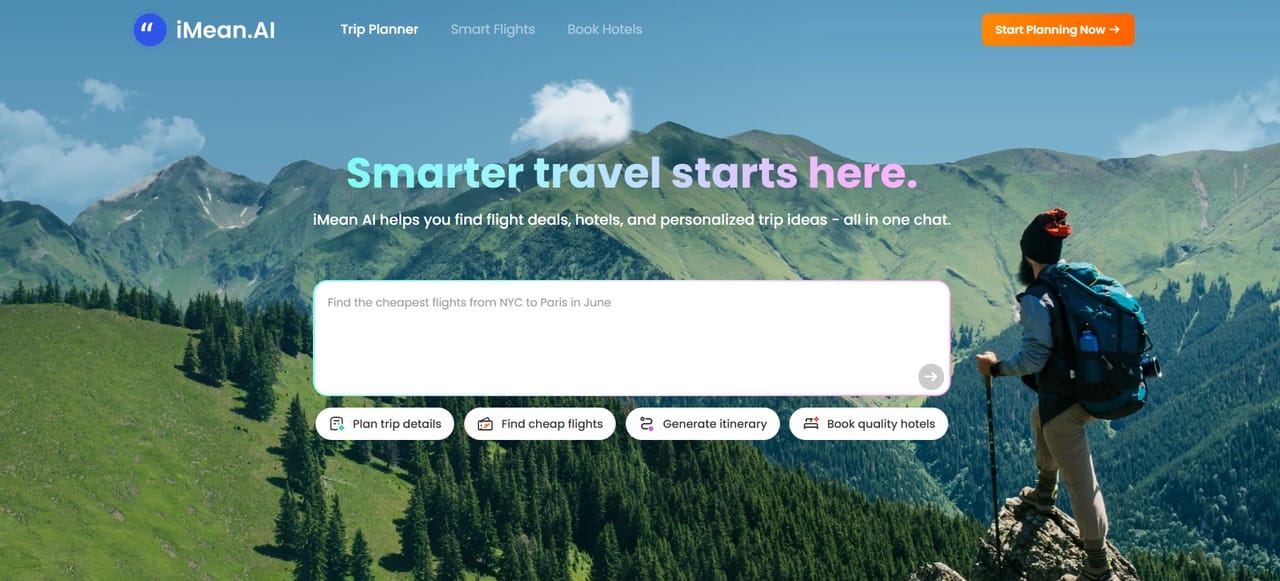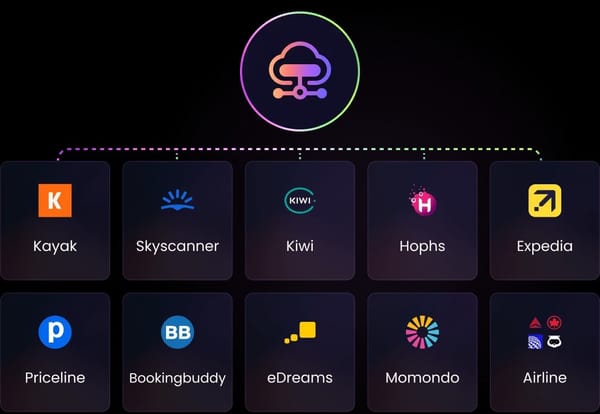Table of Contents
-
AI Technologies Transforming Travel Planning
2-1. From “Old” AI to a 2025 Leap
2-2. Generative AI and LLMs: Natural Conversation at Scale
2-3. Industry Investment and Startup Funding
2-4. Agentic AI: From Reactive to Proactive
2-5. Trust, Accuracy, and Human Oversight -
From Chatbots to Trip Planners: Popular AI Travel Tools in 2025
3-1. Planning by Asking, Not Clicking
3-2. ChatGPT + OTA Integrations
3-3. Specialized Planners (e.g., iMean AI): From Intent to Transaction
3-4. Google’s Generative AI in Search and Maps
3-5. Other Assistants and Social-to-Itinerary Flows
3-6. On-the-Ground: Translation and Visual Understanding -
How Travel Behavior Is Changing in 2025
4-1. Adoption: North America and Europe
4-2. Less Browsing, More Dialog—and Higher Conversion
4-3. Spontaneity, Last-Minute Trips, and “Snackers” Converting
4-4. Group Trips Made Easier; Solo Travel More Confident
4-5. Content Consumption: Creators, Blogs, and Synthetic Influencers -
Impacts on Travel Agencies and the Tourism Industry
5-1. Travel Advisors: AI as a Productivity Booster
5-2. OTAs vs. Suppliers: Data, Loyalty, and Share Shifts
5-3. Tourism Boards: Personalization vs. Homogenization -
Looking Ahead: AI Trends Shaping Travel in 2026
6-1. Even More Autonomous Travel Agents
6-2. New Interfaces: Voice, AR, and Multimodal Guides
6-3. Consumer Behavior and Expectations
6-4. AI-Driven Community and Social Features
6-5. Trust, Transparency, and Safety
6-6. Potential Challenges
6-7. Opportunities for Startups and New Models
Introduction
In 2025, artificial intelligence (AI) has become a trusted travel companion for millions of people. From planning the perfect itinerary to finding hotel deals and even translating signs on the street, AI-powered tools are transforming how we travel. This is a global trend, especially noticeable across North America and Europe, where roughly half of leisure travelers now use AI in some part of their trip planning[1][2].
In this article, we’ll explore how AI has changed travel behavior and services in 2025, and then look ahead to the trends and innovations that could shape travel in 2026. The goal is to keep things accessible and grounded in real-world examples, so you can see exactly how these technologies impact everyday travelers and the industry as a whole.
AI Technologies Transforming Travel Planning
From “Old” AI to a 2025 Leap
AI in travel isn’t entirely new. For years, booking sites have used recommendation algorithms to suggest hotels or flights, and chatbots have handled basic customer service questions. But the past couple of years marked a huge leap in what AI can do for travelers.
Generative AI and LLMs: Natural Conversation at Scale
The advent of large language models (LLMs) like OpenAI’s ChatGPT and Google’s Gemini introduced AI that can converse naturally and generate detailed content on the fly. These generative AI systems can synthesize vast amounts of travel information into human-like answers, making it possible to ask complex travel questions and get coherent, personalized responses in seconds[3]. For example: “Plan me a five-day family vacation to a beach destination under $3,000, leaving from Seattle” – and receive a detailed itinerary almost instantly.
Industry Investment and Startup Funding
Behind the scenes, travel companies rapidly ramped up AI investments. In 2022, few major travel companies even mentioned AI in annual reports, but by 2024 over a third did. Venture capital followed: roughly 10% of travel-tech funding went to AI in 2023, jumping to 45% by mid-2025[4]. This surge is spawning products that go beyond “suggested for you,” adopting advanced ML and neural methods for more intuitive assistance.
Agentic AI: From Reactive to Proactive
One emerging concept is agentic AI. An agentic AI is not just reactive (answering your questions) but proactive, which means it can make decisions and perform tasks on your behalf. Think of an AI that autonomously rebooks your flight during a delay, or adjusts hotel reservations and notifies you. According to a Skift–McKinsey report[4], agentic AI can use multi-step reasoning, call external travel APIs, remember traveler preferences, and handle multi-session requests. We’re not fully there yet in 2025, but companies are actively experimenting.
Trust, Accuracy, and Human Oversight
While AI’s role is growing, challenges remain. Surveys show 90%+ of travelers have some confidence in AI travel info[4], especially for inspiration, but are more cautious on high-stakes matters. Only about 2% are willing to give AI total control to book or change trips without human checks. Occasional “hallucinations”[5] mean humans still keep a hand on the wheel: AI is a supercharged assistant, not a full replacement.

From Chatbots to Trip Planners: Popular AI Travel Tools in 2025
Planning by Asking, Not Clicking
A big 2025 shift: how people plan trips. Instead of scrolling websites, reading endless reviews, and tweaking filters, many now simply ask an AI. As Expedia notes, travelers “aren’t scrolling endless lists… they’re asking questions to find what they want”[6].
ChatGPT + OTA Integrations
ChatGPT is the headline example. Its natural-language planning has been a game-changer. By 2025, travel companies integrated it directly. Expedia partnered with OpenAI to embed live flight/hotel data inside ChatGPT. Now users can see real prices, availability, and images in the chat, then hand off seamlessly to Expedia to book. Booking.com and others have similar moves, turning AI chat into a new front door.
Specialized Planners (e.g., iMean AI): From Intent to Transaction
Dedicated trip planners rose, too. iMean AI positions itself as purpose-built for travel – combining LLM conversation with real-time inventory and booking. The key is bridging inspiration → action. As an iMean article argues, travelers don’t want a “clever itinerary that looks great on paper but is impossible to purchase or risky to execute”[7]. Exactly, a good planner should translate intent into transactions without dumping users back into chaotic search pages.

In practice, these planners check availability/prices and flag tight layover risks or location gotchas. For instance, iMean can propose a Portugal multi-city route, scan current fares, assemble one-ticket combos (for protection), and recommend extra layover time if you’re checking a bag. Outputs emphasize practical advice (“book Alhambra tickets 24h in advance”; “sunset requires reservations”) and can be exported as shareable itineraries.
Google’s Generative AI in Search and Maps
Google infused its products with gen-AI:
- AI Trip Overviews in Search can draft a day-by-day outline from a single query – e.g., “Create an itinerary for a week in Costa Rica focused on nature” [8]– complete with photos, maps, and review snippets, and you can export to Docs or save all places to Maps.
- In Maps, screenshots to plans uses Gemini to detect restaurants/hotels in your screenshots and auto-list them on a map (opt-in).
- Gemini itself answers compound questions across Flights/Search/YouTube in one place, and users can create custom AI “Personas”/Gems tuned to their travel style.

Other Assistants and Social-to-Itinerary Flows
Beyond Bard/Gemini, travel apps are adding AI “assistants.” Kayak launched a beta chat that blends ChatGPT with Kayak’s engine to plan+book on-site[9]. Expedia Trip Matching lets you feed an Instagram Reel and get a corresponding itinerary, bridging social inspiration with execution[9].
On-the-Ground: Translation and Visual Understanding
AI also enhances the in-trip experience. Google Lens translates menus/signs in real time – “watch the words transform right before your eyes” – and can answer “What is this?” about landmarks/customs using visual understanding[8]. It’s a pocket tour guide, especially empowering for solo travelers.
Bottom line: In 2025, travelers have an array of AI tools – from conversational planners (ChatGPT, Bard, iMean) to AI-augmented Search/Maps – making decisions faster and easier.
How Travel Behavior Is Changing in 2025
Adoption: North America and Europe
Surveys in late 2023–2024 showed significant experimentation with gen-AI for trip planning. In North America, over one-third had tried it by late 2023; by early 2024, 41% of U.S./Canada travelers used AI for planning or inspiration[2]. Europe is similar: about 48% of leisure travelers used AI in 2025, up from ~41% a year earlier[1]. Satisfaction is high: 84% of users were satisfied/very satisfied, and nearly half booked most of what AI recommended[3].

Less Browsing, More Dialog—and Higher Conversion
Travelers spend less time on generic sites and more time in AI interfaces. Instead of combing TripAdvisor, someone asks for “a cozy, locally owned hotel in the French countryside with great reviews” and gets a distilled fit. Some independent blogs report traffic declines as AI surfaces answers directly. One blogger cited a ~40% traffic drop and 34% ad-revenue decline in 2024 due to Google’s AI answers[10].
Spontaneity, Last-Minute Trips, and “Snackers” Converting
AI reduces research friction, enabling more spontaneous and ambitious plans. People who casually “snack” on travel ideas get nudged into real trips when AI quickly lays out full plans (flights, hotels, things to do).
Group Trips Made Easier; Solo Travel More Confident
Group planning becomes simpler with shareable itineraries (e.g., iMean AI itinerary planner) that centralize ideas and auto-propose compromises. Solo travelers feel more confident with translation/navigation on demand; Lens translation is especially popular on the go.
Content Consumption: Creators, Blogs, and Synthetic Influencers
AI answers in search displace some blog traffic. Creators pivot to unique, experience-rich storytelling and may deploy chatbots trained on their own archives. Brands experiment with AI influencers and generated content; high-res AI images and video avatars can mimic real travel scenes and speak multiple languages. Still, audiences crave authentic human stories. Tourism boards view AI as a personalization tool to move beyond generic lists, delivering more tailored ideas.

Impacts on Travel Agencies and the Tourism Industry
Travel Advisors: AI as a Productivity Booster
Rather than replacing advisors, AI augments them. Over one-third of advisors report daily AI use (another quarter, a few times a week) for research and drafting. One luxury advisor saw ~40% business growth in six months after using AI for brainstorming/automation, emphasizing: “It’s not replacing us… it gives advisors super-powers”[11].
OTAs vs. Suppliers: Data, Loyalty, and Share Shifts
For OTAs, leading with AI can capture engagement/loyalty. Oliver Wyman estimates OTAs could gain up to 17% more market share by 2029 if suppliers lag—potentially $2B in extra commissions[2]. But as AI aggregates options, brand loyalty could erode; data control and API partnerships become strategic battlegrounds, with regulators watching Europe’s distribution dynamics.
Tourism Boards: Personalization vs. Homogenization
Boards deploy AI chat and itinerary builders trained on official POI data (e.g., wanderboat.ai), boosting satisfaction and long-tail discovery. Tension remains: will algorithms homogenize choices and overcrowd “Top 5” sites, or personalize to spread demand? The savviest boards are digitizing diverse experiences so AI can recommend beyond the usual hits.
Looking Ahead: AI Trends Shaping Travel in 2026
Even More Autonomous Travel Agents
Expect agentic AI to become tangible. Agents will handle end-to-end trips, monitor disruptions, and proactively rebook, seeking approval only when needed. Early versions exist via API-based booking; “human-in-the-loop” checks will remain crucial[12].
New Interfaces: Voice, AR, and Multimodal Guides
Planning by voice (hands-free) will grow. AR overlays may show reviews/history as you look at places. Multimodal generative AI will auto-build personalized digital guides that blend text, maps, and video.
Consumer Behavior and Expectations
Adoption could climb from ~50% in 2025 to 70%+ in 2026 as late adopters join. AI assistance will feel baseline (like hotel Wi-Fi). Expect more micro-trips, bleisure, rising solo travel, and highly niche itineraries as friction falls.
AI-Driven Community and Social Features
Apps may use AI to match travelers with similar plans/interests, curate community advice, and surface meetups, classes, or tours aligned to profiles.
Trust, Transparency, and Safety
Anticipate stronger explainability (“We suggested this hotel because…”) and clearer labels for sponsored/AI-generated content (e.g., EU AI Act trajectories). More granular privacy controls and possibly on-device options for sensitive users.
Potential Challenges
Risks include over-reliance, homogenized experiences, and overlooking small businesses with weak digital footprints. Some roles (support/copywriting) may contract, prompting reskilling toward concierge-style, high-touch service.
Opportunities for Startups and New Models
Expect niche agents (safari, backpacking, LGBTQ+ travel), subscription services for continuous optimization (auto rebook on better deals), and hybrid AI + human consultant models. With AI funding surging, new monetization—affiliate, subscription, savings-share—will proliferate.
Conclusion
In 2025, AI turned trip planning from a tedious chore into a smooth conversation, helping travelers discover tailored experiences and navigate unfamiliar places with confidence. North America and Europe lead adoption, and companies from tech giants to startups are racing to launch chat-based booking, AI itineraries, and smarter recommendations. Creators and advisors are learning to work with AI, adding human value where it matters most.
In 2026, expect more autonomous agents, richer multimodal interfaces, and higher bars for trust and transparency. AI will make travel more accessible and personalized—so long as the industry safeguards accuracy, authenticity, and fairness. For travelers: embrace AI as a co-pilot, verify key details, and let curiosity guide the rest. For the industry: innovate responsibly around the timeless needs of convenience, trust, authenticity, and delight.
Sources:
Sources:
[1]. Gen Z Powers European Travel Boom, Leading in Both Spend and Intent - MMGY Intelligence, 2025.
[2]. Oliver Wyman: Generative AI could be a game changer for travel planning - Consulting.us, 2024
[3]. Generative AI’s Influence On Leisure Traveler Behaviors - Oliver Wyman, 2023
[4]. Remapping travel with agentic AI - Mckinsey, 2025
[5]. The perils of letting AI plan your next trip - BBC, 2025
[6]. The Expedia app, now in ChatGPT - Expedia, 2025
[7]. iMean: How to Go Beyond ChatGPT and Gemini and Truly Make AI Serve Daily Travel Planning - iMean AI, 2025
[8]. 5 tips for summer travel prep - blog.google, 2025
[9]. Kayak and Expedia race to build AI travel agents that turn social posts into itineraries - VentureBeat, 2025
[10]. How Google and AI are Killing Travel Blogs Like Mine - A dangerous business travel blog, 2025
[11]. Some travel advisors are using AI to help plan trips and boost business - Business Insider, 2025
[12]. The Co-Pilot Paradox: How AI Can Rescue—Not Replace—Travel Agents - Forbes, 2025








